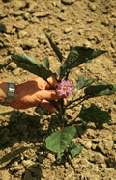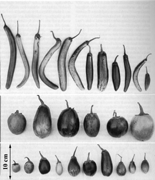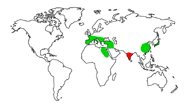Aubergine (Solanum melongena L.)
Nightshade family
(Solanaceae)

| 
|
| Cultivated aubergine with flower | Comparison of the fruits of aubergine varieties
|
Source: Bock.D., MPI Köln; Brücher H., Nutzpfl., Springer Verlag 1977
Distribution, Yield, Use:
Production (1000t) Yield (dt/ha)
| Country | 1979-81 | 1992 | 1979-81 | 1992
|
| China | 1490 | 2420 | 96 | 130
|
| Turkey | 660 | 740 | 169 | 168
|
| Japan | 640 | 500 | 299 | 312
|
| Egypt | 300 | 340 | 211 | 203
|
| Italy | 325 | 240 | 249 | 258
|
| Syria | 175 | 130 | 197 | 192
|
| World | 4660 | 5740 | 127 | 140
|
- Distribution:
The most important countries of production
are China, Turkey, Japan, Egypt and Syria.
High requirement for water and warmth.
- Use:
- Vegetable (boiled, roasted)
The fruit contains 7-10% dry material,
comprising 4-6% carbohydrate, 1-2% protein,
5 mg vitamin C/100 g.

Region of origin:  Region of cultivation:
Region of cultivation: 
- Cultivation and Breeding:
The aubergine comes from tropical India, where the prickly wild variety with relatively small, bitter, anthocyanin-containing berries grows.
The plant reached Europe in the 13th century with the Arabs, and has been grown in Italy since 1550.
The cultivated forms of the plant bear fruits with shapes from egg to sausage shape. They are whitish or black-purple in colour and can weigh up to 1 kg.
- Breeding aims:
Breeding is concentrated on increasing the yield and content of desirable substances (protein, vitamins), resistance to diseases and improving the ability to withstand cold.
Text by
Dr. Wolfgang Schuchert
Adapted to HTML by R.Saedler



 Region of cultivation:
Region of cultivation: 